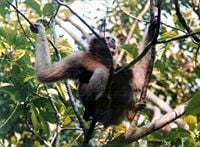Hoolock gibbon
| Hoolock gibbons[1][2] | ||||||||||||
|---|---|---|---|---|---|---|---|---|---|---|---|---|
 | ||||||||||||
| Scientific classification | ||||||||||||
| ||||||||||||
|
Hoolock hoolock |
The hoolock gibbons (Hoolock), also known as hoolocks, are two primate species from the family of the gibbons (Hylobatidae).
Hoolocks are the second largest of the gibbons, after the Siamang. They reach a size of 60 to 90 cm and weigh 6 to 9 kg. The sexes are about the same size, but they differ considerably in coloration: males are black colored with remarkable white brows, while females have a grey-brown fur, which is darker at the chest and neck. White rings around the eyes and around the mouth give their face a mask-like appearance.
The range of the hoolocks is the most northwestern of all the gibbons, extending from Assam in North-East India, to Myanmar. Small populations (in each case few hundred animals) live also in the eastern Bangladesh and in southwest China. Like the other gibbons, they are diurnal and arboreal, brachiating through the trees with their long arms. They live together in monogamous pairs, which stake out a territory. Their calls serve to locate family members and ward off other gibbons from their territory. Their diet consists mainly of fruits, insects and leaves.
Young hoolocks are born after a seven month gestation, with a milky white fur. After about six months their fur turns black. After 8 to 9 years they are fully mature and their fur reaches its final coloration. Their life expectancy in the wild is about 25 years.
Classification
The classification of this gibbon has changed several times in the past few years. Classically, all gibbons were classified in the genus Hylobates, with the exception of the Siamang. After some studies, the genus was divided into three subgenera (including the Siamang's Symphalangus), and then into four (recognizing Bunopithecus as the hoolock subgenus distinct from other gibbon subgenera). These four subgenera were elevated to full genus status. However, the type species for Bunopithecus is Bunopithecus sericus, an extinct gibbon or gibbon-like ape from Sichuan, China. Very recent investigations have shown that the hoolocks are not closely related to B. sericus and so have been placed in their own genus, Hoolock. In the process, the two subspecies of hoolocks have been raised to species level.[1][2]
There are two species of Hoolock:[2]
- Western Hoolock Gibbon, Hoolock hoolock
- Eastern Hoolock Gibbon, Hoolock leuconedys
Western hoolock gibbon
| Western Hoolock Gibbon | ||||||||||||||
|---|---|---|---|---|---|---|---|---|---|---|---|---|---|---|
| Scientific classification | ||||||||||||||
| ||||||||||||||
| Hoolock hoolock (Harlan, 1834) |
The Western Hoolock Gibbon (Hoolock hoolock) is a primate from the Hylobatidae (gibbon) family. The species is found in Assam, Bangladesh and in Myanmar west of the Chindwin River.[4]
Mootnick and Groves[5] stated that the name Bunopithecus was not valid, and placed it in a new genus, Hoolock. This genus was argued to contain two distinct species which were previously thought to be subspecies: Hoolock hoolock and Hoolock leuconedys.[6]
In India and Bangladesh it is found where there is contiguous canopy, broad-leaved, wet evergreen and semi-evergreen forests. The species is an important seed disperser; its diet includes mostly ripe fruits, with some flowers, leaves and shoots.
There are numerous threats to Western hoolock gibbons in the wild, and are now entirely dependent on human action for their survival. Threats include habitat encroachment by humans, forest clearance for tea cultivation, the practice of jhuming (slash-and-burn cultivation), hunting for food and “medicine”, capture for trade, and forest degradation.
Over the last 30-40 years, western hoolock gibbon numbers are estimated to have dropped from more than 100,000 (Assam alone was estimated to have around 80,000 in the early 1970s) to less than 5,000 individuals (a decline of more than 90%).[7]
Eastern hoolock gibbon
ReferencesISBN links support NWE through referral fees
- ↑ 1.0 1.1 C. Groves, "Order Primates," "Order Monotremata," (and select other orders). Page(s) 178-179 in D. E. Wilson and D. M. Reeder, eds., Mammal Species of the World, 3rd edition, Johns Hopkins University Press (2005). ISBN 0801882214.
- ↑ 2.0 2.1 2.2 Mootnick, A. and Groves, C. P. (2005). A new generic name for the hoolock gibbon (Hylobatidae). International Journal of Primatology 26 (26): 971–976.
- ↑ Brockelman, W., Molur, S. & Geissmann, T. (2008). Hoolock hoolock. In: IUCN 2008. IUCN Red List of Threatened Species. Downloaded on 4 January 2009.
- ↑ Groves, C. P. (1967). Geographic variation in the hoolock or white-browed gibbon (Hylobates hoolock harlan 1834).. Folia Primatologica 7: 276–283.
- ↑ Mootnick, A. R. and C. P. Groves (2005). A new generic name for the hoolock gibbon (Hylobatidae). Int. J. Primatol 26: 971–976.
- ↑ Mootnick, A. R. (2006). Gibbon (Hylobatidae) species identification recommended for rescue or breeding centers. Primate Conserv 21: 103–138.
- ↑ Western Hoolock Gibbon, Hoolock hoolock. Retrieved 2008-03-10.
External links
- ARKive - images and movies of the hoolock gibbon (Bunopithecus hoolock)
- Hoolock Gibbon photos
- Hoolock Gibbon songs
- Gibbon Conservation Center
- Hoolock Gibbon Photos Taken in The Wild
- Primate Info Net Hoolock Factsheet
| ||||||||||||||||||||
Credits
New World Encyclopedia writers and editors rewrote and completed the Wikipedia article in accordance with New World Encyclopedia standards. This article abides by terms of the Creative Commons CC-by-sa 3.0 License (CC-by-sa), which may be used and disseminated with proper attribution. Credit is due under the terms of this license that can reference both the New World Encyclopedia contributors and the selfless volunteer contributors of the Wikimedia Foundation. To cite this article click here for a list of acceptable citing formats.The history of earlier contributions by wikipedians is accessible to researchers here:
The history of this article since it was imported to New World Encyclopedia:
Note: Some restrictions may apply to use of individual images which are separately licensed.
